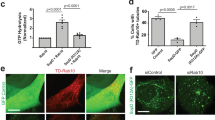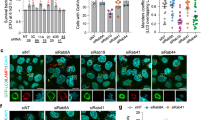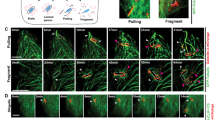Key Points
-
Bacterial and viral pathogens disrupt or exploit RAB11 and exocyst-dependent vesicular trafficking.
-
Innate immune signalling, autophagy and toxin shedding are regulated by RAB11 and the exocyst.
-
Toxins that increase intracellular cyclic AMP levels inhibit endocytic recycling of proteins to cell junctions, thereby disrupting vascular endothelial and epithelial barrier integrity.
-
Bacterial pathogens exploit endocytic recycling to divert host resources to sites of bacterial invasion.
-
Disruption of trafficking from the Golgi complex to recycling endosomes contributes to pathogen replication.
-
Viruses subvert endocytic recycling to exit from host cells.
Abstract
Many bacterial and viral pathogens block or subvert host cellular processes to promote successful infection. One host protein that is targeted by invading pathogens is the small GTPase RAB11, which functions in vesicular trafficking. RAB11 functions in conjunction with a protein complex known as the exocyst to mediate terminal steps in cargo transport via the recycling endosome to cell–cell junctions, phagosomes and cellular protrusions. These processes contribute to host innate immunity by promoting epithelial and endothelial barrier integrity, sensing and immobilizing pathogens and repairing pathogen-induced cellular damage. In this Review, we discuss the various mechanisms that pathogens have evolved to disrupt or subvert RAB11-dependent pathways as part of their infection strategy.
This is a preview of subscription content, access via your institution
Access options
Subscribe to this journal
Receive 12 print issues and online access
$209.00 per year
only $17.42 per issue
Buy this article
- Purchase on Springer Link
- Instant access to full article PDF
Prices may be subject to local taxes which are calculated during checkout




Similar content being viewed by others
References
Stenmark, H. Rab GTPases as coordinators of vesicle traffic. Nature Rev. Mol. Cell Biol. 10, 513–525 (2009).
Heider, M. R. & Munson, M. Exorcising the exocyst complex. Traffic 13, 898–907 (2012).
Kelly, E. E., Horgan, C. P. & McCaffrey, M. W. Rab11 proteins in health and disease. Biochem. Soc. Trans. 40, 1360–1367 (2012).
Lim, Y. S., Chua, C. E. & Tang, B. L. Rabs and other small GTPases in ciliary transport. Biol. Cell 103, 209–221 (2011).
Knodler, A. et al. Coordination of Rab8 and Rab11 in primary ciliogenesis. Proc. Natl Acad. Sci. USA 107, 6346–6351 (2010).
Apodaca, G. Opening ahead: early steps in lumen formation revealed. Nature Cell Biol. 12, 1026–1028 (2010).
Novick, P. et al. Interactions between Rabs, tethers, SNAREs and their regulators in exocytosis. Biochem. Soc. Trans. 34, 683–686 (2006).
Husebye, H. et al. The Rab11a GTPase controls Toll-like receptor 4-induced activation of interferon regulatory factor-3 on phagosomes. Immunity 33, 583–596 (2010). This study identifies RAB11 as an important regulator of TLR4 and TRAM transport to E. coli phagosomes to activate interferon regulatory factor 3 (IRF3) expression.
Los, F. C. et al. RAB-5- and RAB-11-dependent vesicle-trafficking pathways are required for plasma membrane repair after attack by bacterial pore-forming toxin. Cell Host Microbe 9, 147–157 (2011).
Ishikawa, H., Ma, Z. & Barber, G. N. STING regulates intracellular DNA-mediated, type I interferon-dependent innate immunity. Nature 461, 788–792 (2009).
Simicek, M. et al. The deubiquitylase USP33 discriminates between RALB functions in autophagy and innate immune response. Nature Cell Biol. 15, 1220–1230 (2013).
Prigent, M. et al. ARF6 controls post-endocytic recycling through its downstream exocyst complex effector. J. Cell Biol. 163, 1111–1121 (2003).
Fielding, A. B. et al. Rab11-FIP3 and FIP4 interact with Arf6 and the exocyst to control membrane traffic in cytokinesis. EMBO J. 24, 3389–3399 (2005).
Guichard, A. et al. Anthrax toxins cooperatively inhibit endocytic recycling by the Rab11/Sec15 exocyst. Nature 467, 854–858 (2010). This paper shows that RAB11 and the exocyst are targets that are inhibited by the anthrax toxins EF and LF, respectively, thereby causing loss of barrier function.
Guichard, A. et al. Cholera toxin disrupts barrier function by inhibiting exocyst-mediated trafficking of host proteins to intestinal cell junctions. Cell Host Microbe 14, 294–305 (2013). This study shows that, in addition to its well-appreciated role in stimulating Cl− ion secretion, cholera toxin also weakens cell junctions to enable the efflux of Na+ ions and water in the gut lumen.
Nichols, C. D. & Casanova, J. E. Salmonella-directed recruitment of new membrane to invasion foci via the host exocyst complex. Curr. Biol. 20, 1316–1320 (2010).
Brock, S. C., Goldenring, J. R. & Crowe, J. E. Jr. Apical recycling systems regulate directional budding of respiratory syncytial virus from polarized epithelial cells. Proc. Natl Acad. Sci. USA 100, 15143–15148 (2003).
Rowe, R. K., Suszko, J. W. & Pekosz, A. Roles for the recycling endosome, Rab8, and Rab11 in hantavirus release from epithelial cells. Virology 382, 239–249 (2008). This study reports the discovery that RAB8 and RAB11 colocalize with ANDV proteins during infection and that downregulation of RAB11 and RAB8 proteins reduce viral secretion from host cells, thereby implicating the recycling endosome and these RAB proteins in hantavirus trafficking to the plasma membrane.
Mounier, J. et al. Shigella effector IpaB-induced cholesterol relocation disrupts the Golgi complex and recycling network to inhibit host cell secretion. Cell Host Microbe 12, 381–389 (2012). This paper shows that Shigella spp. recruits cholesterol to sites of bacterial invasion, which leads to fragmentation of the Golgi complex, inhibition of endocytic trafficking and disruption of host epithelial barriers.
Rejman Lipinski, A. et al. Rab6 and Rab11 regulate Chlamydia trachomatis development and golgin-84-dependent Golgi fragmentation. PLoS Pathog. 5, e1000615 (2009). This study shows that RAB6 and RAB11 are key regulators of Golgi stability and further shows that C. trachomatis functions via these small GTPases to disrupt Golgi complex structure and promote its intracellular development.
Koch, R. (ed.) Beitrage zur Biologie der Pflanzen Vol. 2 (J. U. Kern's Verlag (Max Müller)) (in German) (1876).
Koch, R. Sechster Bericht der deutschen Wissenschaftlichen Commission zur Enforschung der Cholera, Geh Regierungsraths Dr Koch. Dtsch. Med. Wochenschr. 10, 191–192 (in German) (1884).
Chamberland, C. (ed). Le charbon et la vaccination charbonneuse d'apres les travaux recents de M. Pasteur (ed. Tignol, B.) (Bernard Tignol) (in French) (1883).
Pasteur, L., Chamberland, C. & Roux, E. Compte rendu sommaire des experiences faites a Pouilly-le-Fort, pres Melun, sur la vaccination charbonneuse. Cr. Acad. Sci. Paris 92, 1393–1398 (in French) (1881).
Guichard, A., Nizet, V. & Bier, E. New insights into the biological effects of anthrax toxins: linking cellular to organismal responses. Microbes Infect. 14, 97–118 (2012).
Mourez, M. Anthrax toxins. Rev. Physiol. Biochem. Pharmacol. 152, 135–164 (2004).
Liu, S. et al. Anthrax toxin targeting of myeloid cells through the CMG2 receptor is essential for establishment of Bacillus anthracis infections in mice. Cell Host Microbe 8, 455–462 (2010).
Pezard, C., Berche, P. & Mock, M. Contribution of individual toxin components to virulence of Bacillus anthracis. Infect. Immun. 59, 3472–3477 (1991).
Liu, S. et al. Key tissue targets responsible for anthrax-toxin-induced lethality. Nature 501, 63–68 (2013).
Brand, A. H. & Perrimon, N. Targeted gene expression as a means of altering cell fates and generating dominant phenotypes. Development 118, 401–415 (1993).
Guichard, A., Park, J. M., Cruz-Moreno, B., Karin, M. & Bier, E. Anthrax lethal factor and edema factor act on conserved targets in Drosophila. Proc. Natl Acad. Sci. USA 103, 3244–3249 (2006).
Jafar-Nejad, H. et al. Sec15, a component of the exocyst, promotes Notch signaling during the asymmetric division of Drosophila sensory organ precursors. Dev. Cell 9, 351–363 (2005).
De Haan, L. & Hirst, T. R. Cholera toxin: a paradigm for multi-functional engagement of cellular mechanisms. Mol. Membr. Biol. 21, 77–92 (2004).
Sack, D. A., Sack, R. B., Nair, G. B. & Siddique, A. K. Cholera. Lancet 363, 223–233 (2004).
Barrett, K. E. & Keely, S. J. Chloride secretion by the intestinal epithelium: molecular basis and regulatory aspects. Annu. Rev. Physiol. 62, 535–572 (2000).
Gabriel, S. E., Brigman, K. N., Koller, B. H., Boucher, R. C. & Stutts, M. J. Cystic fibrosis heterozygote resistance to cholera toxin in the cystic fibrosis mouse model. Science 266, 107–109 (1994).
Mathan, M. M., Chandy, G. & Mathan, V. I. Ultrastructural changes in the upper small intestinal mucosa in patients with cholera. Gastroenterology 109, 422–430 (1995).
Ahuja, N., Kumar, P. & Bhatnagar, R. The adenylate cyclase toxins. Crit. Rev. Microbiol. 30, 187–196 (2004).
Sears, C. L. & Kaper, J. B. Enteric bacterial toxins: mechanisms of action and linkage to intestinal secretion. Microbiol. Rev. 60, 167–215 (1996).
Weiglmeier, P. R., Rosch, P. & Berkner, H. Cure and curse: E. coli heat-stable enterotoxin and its receptor guanylyl cyclase C. Toxins 2, 2213–2229 (2010).
Brumell, J. H. & Scidmore, M. A. Manipulation of Rab GTPase function by intracellular bacterial pathogens. Microbiol. Mol. Biol. Rev. 71, 636–652 (2007).
Ray, K., Marteyn, B., Sansonetti, P. J. & Tang, C. M. Life on the inside: the intracellular lifestyle of cytosolic bacteria. Nature Rev. Microbiol. 7, 333–340 (2009).
Hayward, R. D. & Koronakis, V. Direct nucleation and bundling of actin by the SipC protein of invasive Salmonella. EMBO J. 18, 4926–4934 (1999).
Rzomp, K. A., Scholtes, L. D., Briggs, B. J., Whittaker, G. R. & Scidmore, M. A. Rab GTPases are recruited to chlamydial inclusions in both a species-dependent and species-independent manner. Infect. Immun. 71, 5855–5870 (2003).
Varthakavi, V. et al. The pericentriolar recycling endosome plays a key role in Vpu-mediated enhancement of HIV-1 particle release. Traffic 7, 298–307 (2006).
Sfakianos, J. N. & Hunter, E. M-PMV capsid transport is mediated by Env/Gag interactions at the pericentriolar recycling endosome. Traffic 4, 671–680 (2003).
Sayner, S. L. et al. Paradoxical cAMP-induced lung endothelial hyperpermeability revealed by Pseudomonas aeruginosa ExoY. Circ. Res. 95, 196–203 (2004).
Sack, R. B. The discovery of cholera-like enterotoxins produced by Escherichia coli causing secretory diarrhoea in humans. Indian J. Med. Res. 133, 171–180 (2011).
Carbonetti, N. H. Pertussis toxin and adenylate cyclase toxin: key virulence factors of Bordetella pertussis and cell biology tools. Future Microbiol. 5, 455–469 (2010).
Bai, G., Knapp, G. S. & McDonough, K. A. Cyclic AMP signalling in mycobacteria: redirecting the conversation with a common currency. Cell. Microbiol. 13, 349–358 (2011).
Wang, M. et al. Microbial hijacking of complement–Toll-like receptor crosstalk. Sci. Signal 3, ra11 (2010).
Michankin, B. N., Chevchenko, L. A. & Asseeva, L. E. Adenylate cyclase. A possible factor in the pathogenicity of Yersinia pestis. Bull. Soc. Pathol. Exot. 85, 17–21 (1992).
Bliska, J. B. Yersinia inhibits host signaling by acetylating MAPK kinases. ACS Chem. Biol. 1, 349–351 (2006).
Huffman, D. L. et al. Mitogen-activated protein kinase pathways defend against bacterial pore-forming toxins. Proc. Natl Acad. Sci. USA 101, 10995–11000 (2004).
Park, J. M., Ng, V. H., Maeda, S., Rest, R. F. & Karin, M. Anthrolysin O and other Gram-positive cytolysins are Toll-like receptor 4 agonists. J. Exp. Med. 200, 1647–1655 (2004).
Moayeri, M. & Leppla, S. H. Cellular and systemic effects of anthrax lethal toxin and edema toxin. Mol. Aspects Med. 30, 439–455 (2009).
Tournier, J. N., Rossi Paccani, S., Quesnel-Hellmann, A. & Baldari, C. T. Anthrax toxins: a weapon to systematically dismantle the host immune defenses. Mol. Aspects Med. 30, 456–466 (2009).
Queen, J. & Satchell, K. J. Promotion of colonization and virulence by cholera toxin is dependent on neutrophils. Infect. Immun. 81, 3338–3345 (2013).
Grinberg, L. M., Abramova, F. A., Yampolskaya, O. V., Walker, D. H. & Smith, J. H. Quantitative pathology of inhalational anthrax I: quantitative microscopic findings. Mod. Pathol. 14, 482–495 (2001).
Ishikawa, H. & Barber, G. N. STING is an endoplasmic reticulum adaptor that facilitates innate immune signalling. Nature 455, 674–678 (2008). This paper shows that STING is essential for recognition of viral dsDNA and that it induces innate signalling via interactions with the exocyst complex.
Chien, Y. et al. RalB GTPase-mediated activation of the IκB family kinase TBK1 couples innate immune signaling to tumor cell survival. Cell 127, 157–170 (2006).
Cherry, S. Genomic RNAi screening in Drosophila S2 cells: what have we learned about host–pathogen interactions? Curr. Opin. Microbiol. 11, 262–270 (2008).
Guttman, J. A. & Finlay, B. B. Tight junctions as targets of infectious agents. Biochim. Biophys. Acta 1788, 832–841 (2009).
Wilke, G. A. & Bubeck Wardenburg, J. Role of a disintegrin and metalloprotease 10 in Staphylococcus aureus α-hemolysin-mediated cellular injury. Proc. Natl Acad. Sci. USA 107, 13473–13478 (2010).
Berube, B. J. & Bubeck Wardenburg, J. Staphylococcus aureus α-toxin: nearly a century of intrigue. Toxins 5, 1140–1166 (2013).
Powers, M. E., Kim, H. K., Wang, Y. & Bubeck Wardenburg, J. ADAM10 mediates vascular injury induced by Staphylococcus aureus α-hemolysin. J. Infect. Dis. 206, 352–356 (2012).
Inoshima, N., Wang, Y. & Bubeck Wardenburg, J. Genetic requirement for ADAM10 in severe Staphylococcus aureus skin infection. J. Invest. Dermatol. 132, 1513–1516 (2012).
Inoshima, I. et al. A Staphylococcus aureus pore-forming toxin subverts the activity of ADAM10 to cause lethal infection in mice. Nature Med. 17, 1310–1314 (2011). This study shows that ADAM10 functions as the host receptor for the S. aureus PFT α-toxin, which leads to cleavage of E-cadherin and weakens epithelial barriers.
Weber, S. et al. The disintegrin/metalloproteinase Adam10 is essential for epidermal integrity and Notch-mediated signaling. Development 138, 495–505 (2011).
Gibb, D. R. et al. ADAM10 is essential for Notch2-dependent marginal zone B cell development and CD23 cleavage in vivo. J. Exp. Med. 207, 623–635 (2010).
Tian, L. et al. ADAM10 is essential for proteolytic activation of Notch during thymocyte development. Int. Immunol. 20, 1181–1187 (2008).
Hartmann, D. et al. The disintegrin/metalloprotease ADAM 10 is essential for Notch signalling but not for α-secretase activity in fibroblasts. Hum. Mol. Genet. 11, 2615–2624 (2002).
Wen, C., Metzstein, M. M. & Greenwald, I. SUP-17, a Caenorhabditis elegans ADAM protein related to Drosophila KUZBANIAN, and its role in LIN-12/NOTCH signalling. Development 124, 4759–4767 (1997).
Pan, D. & Rubin, G. M. Kuzbanian controls proteolytic processing of Notch and mediates lateral inhibition during Drosophila and vertebrate neurogenesis. Cell 90, 271–280 (1997).
Debellis, L. et al. The Vibrio cholerae cytolysin promotes chloride secretion from intact human intestinal mucosa. PLoS ONE 4, e5074 (2009).
Valeva, A. et al. A cellular metalloproteinase activates Vibrio cholerae pro-cytolysin. J. Biol. Chem. 279, 25143–25148 (2004).
Husmann, M. et al. Elimination of a bacterial pore-forming toxin by sequential endocytosis and exocytosis. FEBS Lett. 583, 337–344 (2009).
Husmann, M. et al. Differential role of p38 mitogen activated protein kinase for cellular recovery from attack by pore-forming S. aureus α-toxin or streptolysin O. Biochem. Biophys. Res. Commun. 344, 1128–1134 (2006).
Lizak, M. & Yarovinsky, T. O. Phospholipid scramblase 1 mediates type I interferon-induced protection against staphylococcal α-toxin. Cell Host Microbe 11, 70–80 (2012).
Ali, S. R. et al. Anthrax toxin induces macrophage death by p38 MAPK inhibition but leads to inflammasome activation via ATP leakage. Immunity 35, 34–44 (2011).
Smith, H. & Keppie, J. Observations on experimental anthrax; demonstration of a specific lethal factor produced in vivo by Bacillus anthracis. Nature 173, 869–870 (1954).
Chitlaru, T., Altboum, Z., Reuveny, S. & Shafferman, A. Progress and novel strategies in vaccine development and treatment of anthrax. Immunol. Rev. 239, 221–236 (2011).
Acknowledgements
The authors thank E. Troemel and members of the Bier and Nizet laboratories for helpful comments and discussions on the manuscript. They also acknowledge funding from the following US National Institutes of Health (NIH) R01 grants: AI070654 (to E.B.), AI057153 (to V.N.) and AI110713 (to E.B. and V.N.), which have supported their studies on topics covered in this Review.
Author information
Authors and Affiliations
Corresponding authors
Ethics declarations
Competing interests
The authors declare no competing financial interests.
Glossary
- Recycling endosomes
-
Late vesicular compartments that are involved in recycling membrane proteins and de novo synthesized cargo from the Golgi complex to the cell surface.
- SNARE complexes
-
(Soluble NSF attachment protein receptor complexes). A family of related proteins that mediate the fusion of surface-bound vesicles with the plasma membrane (for example, SNAP25, a plasma membrane tethered SNARE and a vesicular SNARE form a trimeric complex to initiate membrane fusion).
- Invadosomes
-
Subcellular structures that derive from the plasma membrane and mediate bacterial invasion of the host cell.
- Notch signalling
-
A signalling pathway that controls a range of cell fate and growth decisions. It is activated at adherens junctions by cell surface-tethered ligands (for example, Delta) on one cell, which stimulate Notch receptors on adjacent cells.
- Adherens junctions
-
Subapically localized cell–cell junctions that consist of transmembrane epithelial cadherin adhesion molecules, which interact with the cytoskeleton via α-catenins and β-catenins and link epithelial and endothelial cells, enabling them to form contiguous sheets.
- Tight junctions
-
The most apically localized cell–cell junctions; they consist of adhesive claudins and occludin transmembrane proteins, which function as a diffusion barrier to ions, water and other small molecules.
- Toxisome
-
A vesicle that contains toxic factors and that is expelled from the cell surface (for example, shed microvilli).
- Anterograde Golgi trafficking
-
A pathway via which vesicles that are derived from Golgi membranes are directed to the cell surface via anterograde trafficking. In addition, vesicles that are derived from the cell surface or other intracellular membrane compartments can be directed back to the Golgi via retrograde trafficking.
- RALB
-
A small GTPase that can bind in a mutually exclusive manner to either of the exocyst components SEC5 or EXO84 to function as a molecular switch between immune signalling and autophagy.
Rights and permissions
About this article
Cite this article
Guichard, A., Nizet, V. & Bier, E. RAB11-mediated trafficking in host–pathogen interactions. Nat Rev Microbiol 12, 624–634 (2014). https://doi.org/10.1038/nrmicro3325
Published:
Issue Date:
DOI: https://doi.org/10.1038/nrmicro3325
This article is cited by
-
SARS-CoV-2 spike receptor-binding domain is internalized and promotes protein ISGylation in human induced pluripotent stem cell-derived cardiomyocytes
Scientific Reports (2023)
-
The Regulatory Mechanism of Rab21 in Human Diseases
Molecular Neurobiology (2023)
-
Renal protein reabsorption impairment related to a myxosporean infection in the grass frog (Rana temporaria L.)
Parasitology Research (2023)
-
Evaluation of the relationship between the 14-3-3ε protein and LvRab11 in the shrimp Litopenaeus vannamei during WSSV infection
Scientific Reports (2021)
-
Human DEF6 deficiency underlies an immunodeficiency syndrome with systemic autoimmunity and aberrant CTLA-4 homeostasis
Nature Communications (2019)



